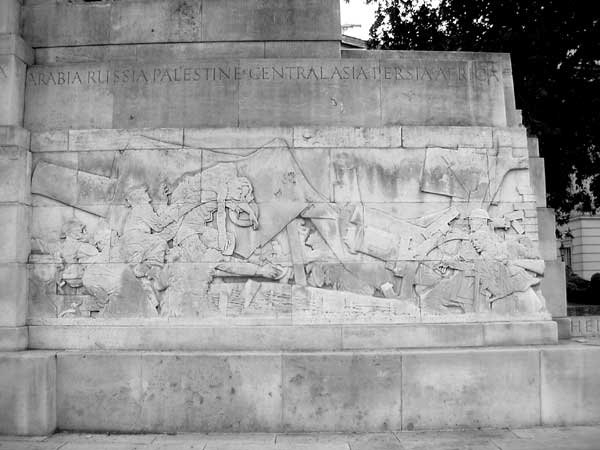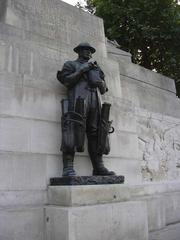
Royal Artillery Memorial: Visiting Hours, Tickets, and Historical Significance in London
Date: 15/06/2025
Introduction
Standing at the bustling Hyde Park Corner in London, the Royal Artillery Memorial is an enduring tribute to the courage and sacrifice of the Royal Regiment of Artillery during the First World War. Unveiled in 1925, this monument is renowned for its uncompromising realism and powerful symbolism, offering visitors a unique opportunity to reflect on the true cost of war. Designed by sculptor Charles Sargeant Jagger—himself a war veteran—and architect Lionel Pearson, the memorial features a full-scale 9.2-inch howitzer atop a massive Portland stone plinth, surrounded by four lifelike bronze figures representing artillerymen in various roles. This guide delivers an all-encompassing look at the memorial’s history, design, visitor information, accessibility, nearby attractions, and practical tips, ensuring a meaningful and informed visit to one of London’s most significant historic sites. For further context, see Historic England and War Memorials Online.
Table of Contents
- Introduction
- Historical Background
- Visiting the Royal Artillery Memorial
- Nearby Attractions
- Frequently Asked Questions (FAQ)
- Conclusion
- References
Historical Background
Origins and Purpose
The Royal Artillery Memorial was conceived to honor the 49,076 members of the Royal Regiment of Artillery who lost their lives in the Great War. The Royal Artillery War Commemoration Fund (RAWCF) established the memorial in 1919, with a clear vision: to emphasize the artillery’s vital role and the human cost of the conflict. Initial designs were rejected for lacking authenticity, leading to the commission of Jagger and Pearson, whose approach focused on realism and direct representation of artillery service.
Design and Construction
Commissioned in 1921, Charles Sargeant Jagger and Lionel Pearson designed the memorial to be both monumental and deeply human. Jagger’s personal experience as a Western Front veteran informed his realistic style, realized in four massive bronze figures—each depicting a distinct artillery role: the Driver, Gunner, Shell Carrier, and a rare recumbent Fallen Soldier. The centerpiece, a stone howitzer covered with a tarpaulin, symbolizes the silencing of the guns at war’s end (Historic England).
The memorial’s construction was completed in 1925. Cast by the esteemed A.B. Burton foundry and built from Portland stone, it measures approximately 12 meters long and 7 meters high, exuding a sense of permanence and gravity (War Memorials Online).
Symbolism and Artistic Features
Jagger’s design breaks from tradition by presenting the realities of war rather than idealized heroism. The four bronze figures are:
- Driver: Depicted in a greatcoat with helmet, hands in pockets, representing resilience.
- Gunner: Focused and resolute, holding a shell.
- Shell Carrier (Loader): Straining under the weight of a shell, embodying the physical demands of artillery service.
- Fallen Soldier: Lifelike and vulnerable, shrouded in a greatcoat—one of the most poignant images of death in British war memorial sculpture.
Low-relief carvings on the sides depict artillerymen in action, echoing ancient Assyrian motifs, while inscriptions commemorate the sacrifices of World War I and subsequent conflicts. The word UBIQUE (“everywhere”)—the Royal Artillery’s motto—emphasizes the regiment’s global service.
Historical Significance
Initially controversial for its stark depiction of death, the memorial is now celebrated as a masterpiece of commemorative art, influencing later war memorials in the UK and abroad. It was upgraded to Grade I listed status in 2011 after significant restoration, securing its legacy as one of the nation’s most important monuments (Historic England).
Visiting the Royal Artillery Memorial
Location and Access
- Address: Hyde Park Corner, Westminster, London, W1J 7JZ
- Nearest Underground Stations: Hyde Park Corner (Piccadilly Line), Green Park (Victoria, Jubilee, and Piccadilly Lines)
- Map: Google Maps
The memorial is situated on a prominent traffic island at Hyde Park Corner, surrounded by other notable landmarks.
Visiting Hours and Admission
- Hours: Open 24 hours a day, 7 days a week.
- Admission: Free; no tickets required.
As a public outdoor monument, the Royal Artillery Memorial is accessible at any time. For the best experience, visit during daylight hours to appreciate the intricate details of the sculptures.
Accessibility
- Wheelchair Access: The area around the memorial is paved and level, suitable for wheelchairs and mobility aids.
- Caution: The memorial sits on a busy traffic island; use pedestrian crossings and exercise care when accessing the site.
Travel Tips
- Best Times: Early mornings or late afternoons are quieter and offer favorable lighting for photographs.
- Transport: Use public transport due to limited parking in the area.
- Safety: Keep valuables secure in this busy urban setting.
Guided Tours and Events
Although there is no dedicated visitor center, the memorial is frequently included in military history and Hyde Park Corner walking tours. Private guides and group tours can be booked through local providers (London War Memorials Walking Tour). Special events, notably on Remembrance Day (11th November), include wreath-laying ceremonies and moments of silence.
Nearby Attractions
The Royal Artillery Memorial is part of a cluster of significant memorials and landmarks:
- Wellington Arch: Offers exhibitions and panoramic city views (English Heritage).
- Apsley House: The historic home of the Duke of Wellington.
- Australian War Memorial and Machine Gun Corps Memorial: Both located within Hyde Park Corner.
- Green Park and Hyde Park: Expansive public parks for relaxation and further exploration.
For a comprehensive experience, consider a self-guided walking tour covering these sites (Ruth Siddall & Diana Clements, 2013).
Frequently Asked Questions (FAQ)
Q: What are the Royal Artillery Memorial visiting hours?
A: The memorial is open 24 hours a day, year-round.
Q: Is there an entry fee or ticket required?
A: No, the memorial is free to visit and does not require tickets.
Q: Is the memorial wheelchair accessible?
A: Yes, the memorial is accessible via paved surfaces, though care should be taken when crossing roads.
Q: Are guided tours available?
A: The memorial is included in many local walking tours. Private guides and group tours can be arranged.
Q: Can I take photographs?
A: Yes, photography is permitted; be respectful, especially during ceremonies.
Q: What nearby attractions can I visit?
A: Wellington Arch, Apsley House, the Australian War Memorial, Green Park, and Hyde Park are all within easy walking distance.
Conclusion
The Royal Artillery Memorial stands among London’s most important historical sites, blending striking realism and artistic mastery with deep commemorative purpose. Its lifelike sculptures and powerful inscriptions honor the fallen artillerymen of World War I, while its accessible location invites all visitors to engage with history and reflection. Whether visiting independently or as part of a guided tour, the memorial offers profound insights into military history and public remembrance. Plan your visit to this remarkable London landmark and discover the enduring legacy of the Royal Regiment of Artillery.
For further guides, audio tours, and interactive maps, download the Audiala app or visit our website. Stay updated on events and new content by following us on social media.
References and Further Reading
- Historic England Listing
- War Memorials Online
- Visit London
- London War Memorials Walking Tour
- Ruth Siddall & Diana Clements, Hyde Park Corner Walks (PDF)
- English Heritage: Wellington Arch




















































































































































































































































